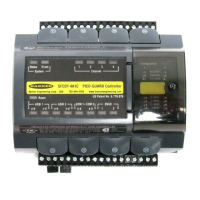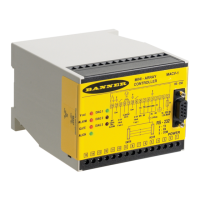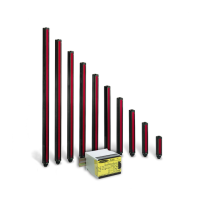Inputs Outputs
Modbus Register Address
(Decimal)
Description (Inputs) Modbus Register
Address (Decimal)
Description (Outputs)
6611–6613 Input 1 from all devices 6691–6693 Output 1 from all devices
6621–6623 Input 2 from all devices 6701–6703 Output 2 from all devices
6631–6633 Input 3 from all devices 6711–6713 Output 3 from all devices
6641–6643 Input 4 from all devices 6721–6723 Output 4 from all devices
6651–6653 Input 5 from all devices 6731–6733 Output 5 from all devices
6661–6663 Input 6 from all devices 6741–6743 Output 6 from all devices
6671–6673 Input 7 from all devices 6751–6753 Output 7 from all devices
6681–6683 Input 8 from all devices
Status registers (6601–6603) contain a bit-packed representation defining the devices that are operational in the wireless
system. Each bit indicates Node in Sync (1) or Node Not in Sync (0).
A one (1) written to the Discrete Status Register area indicates the device is active within the wireless system. A zero (0)
indicates the device is not active within the wireless network.
Input registers from all devices use Modbus registers 6611 through 6683 to organize the least significant bit into a
sequential array of registers. The first register contains the least significant bit from the input values for the Gateway through
Node 15. The second register contains the input values for Node 16 through Node 31, and the third register contains the
input values for Nodes 32 through 47.
For discrete inputs, only the least significant bit is used. For analog inputs, the least significant bit indicates if the analog
value is above or below the selected threshold value (when using the threshold parameter configured in the User
Configuration Software). For example, a least significant bit of one (1) indicates the analog value is above the selected
threshold value. A least significant bit of zero (0) indicates the analog value is below the threshold value.
Output registers from all devices use Modbus registers 6691 through 6753 to organize the least significant bit into a
sequential array of registers. Output 8 (I/O point 16) cannot be written using the discrete format.
Analog 16-Bit Registers (Registers 6801 through 9098)
The most efficient way to read (or write) analog data from a Gateway is by using these 16-bit analog registers. Most networks
consist of similar Nodes reporting data using the same I/O registers for each Node. For this reason, the analog data is
arranged by I/O point using Modbus registers 6801 through 9098.
For example, Input 1 for Gateway and all Nodes is stored in the first 48 contiguous blocks of 16-bit analog registers,
beginning with register 6801.
In this format, users can read a 16-bit holding register for all devices or write to a register for all devices using one Modbus
message. Using these registers is the most efficient way to read all status registers, read all analog inputs, or write all analog
outputs.
The following registers contain analog I/O values for the Gateway and all Nodes. Values are stored first for the Gateway,
then for each Node in order of Node address.
Table 11: Analog input and output registers
Inputs
Outputs
Modbus Register Address
(Decimal)
Description (Inputs) Modbus Register Address
(Decimal)
Description (Outputs)
6801 Input 1 for Gateway 8001 Output 1 for Gateway
6802 Input 1 for Node 1 8002 Output 1 for Node 1
6803 Input 1 for Node 2 8003 Output 1 for Node 2
... ... ... ...
6951 Input 2 for Gateway 8151 Output 2 for Gateway
6952 Input 2 for Node 1 8152 Output 2 for Node 1
6953 Input 2 for Node 2 8153 Output 2 for Node 2
... ... ... ...
Sure Cross
®
DXM700-Bx Wireless Controller
22 www.bannerengineering.com - Tel: + 1 888 373 6767
